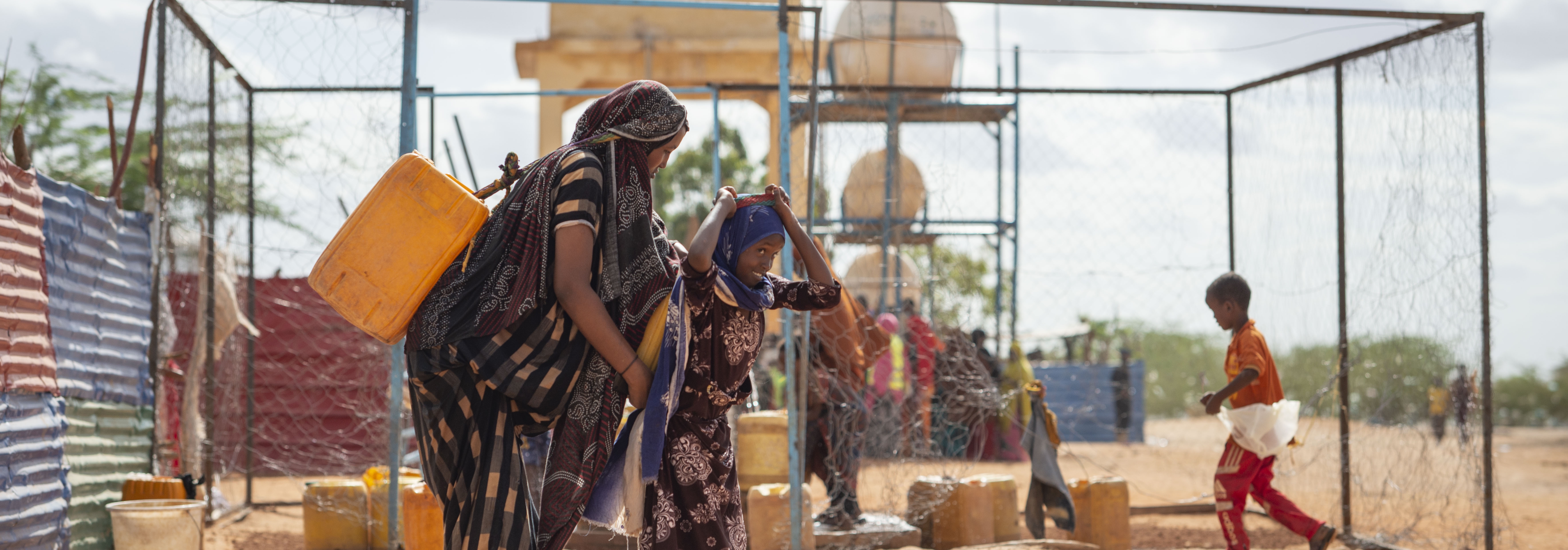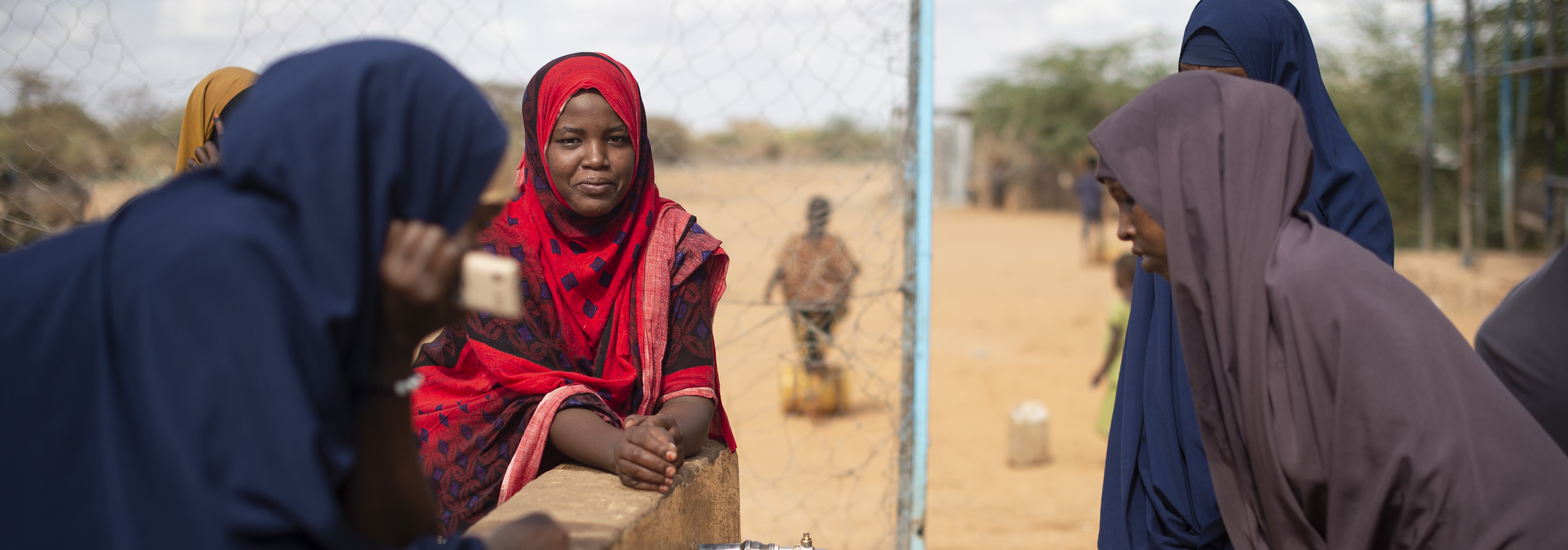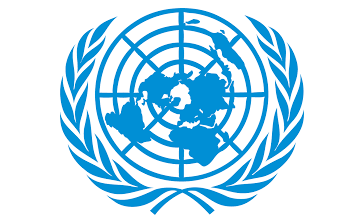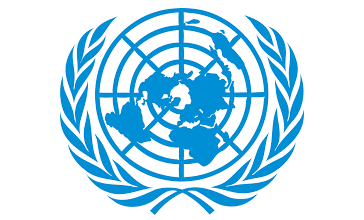IOM Vision
IOM Somalia aims to save lives, alleviate suffering and maintain human dignity through the delivery of frontline services to crisis-affected populations, while steadily developing models and partnerships for longer-term recovery and migration governance. IOM is strategically well-placed to operationalise the humanitarian-development-peace nexus through its vast portfolio. IOM aims to catalyse programming from multiple units to provide more holistic support to communities in a way that reinforces government legitimacy and enables the government to deliver services.
Objective
Saving lives and protecting people on the move
Internally displaced persons (IDPs) and crisis and climate-affected populations including vulnerable host communities, returnees, and migrants.
IOM will continue CCCM activities in Baidoa, Dollow and Kismayo. Activities include:
- Coordinate the delivery of multisectoral services in sites by representing CCCM in relevant coordination forums;
- Conduct site verifications on a quarterly basis, map the services available in sites, and monitor service delivery in sites;
- Improve the living conditions of displaced people by supporting community-led site maintenance activities to ensure the upkeep of sites;
- Conduct safety audits to identify areas of high protection risk and implement emergency sites improvement projects to minimize protection risks and ensure safety in sites;
- In coordination with the local authorities and protection actors, develop new land for the relocation of displaced people and facilitate decongestion activities to attain minimum living standards for IDPs;
- Strengthen community self-management and access to information for displaced populations by supporting diverse and inclusive governance structures;
- Provide capacity building to existing governance structures on CCCM and related principles;
- Provide community spaces for management committees;
- Operate timely and responsive feedback and complaint mechanisms - accessible at help desks in community centres through outreach teams or via a toll-free hotline.
In 2021, IOM will support the operation of 33 fixed health care facilities with integrated community outreach and expand 18 mobile teams in targeted areas, many of which are in hard-to-reach, remote, or conflict-affected areas with limited or no health actors, which results in the population not having access to basic life-saving health services. Health services will be provided in line with the national Essential Package of Health Services (EPHS) framework for service delivery. Activities include:
-
Strengthen the capacity of health workers to ensure the delivery of high-quality medical service through the provision of trainings;
-
Support basic infrastructure rehabilitation and renovation to existing health facilities to ensure health facility functionality and a safe environment;
-
Preposition essential medicines, medical supplies, medical equipment, personal protective equipment and infection prevention and control supplies to ensure uninterrupted supply in the event of an emergency;
-
Support mass vaccination at the entrance points to IDP sites, thus increasing immunization coverage and reducing outbreaks of communicable diseases;
-
Facilitate the deployment of rapid response teams at key points of entry to enhance surveillance at points of entry through screening and referrals in the event of a public health emergency;
-
Provide maternal health care and newborn care, including safe deliveries, emergency obstetric, and sexual and reproductive health services;
-
Provide health education at the health facilities and during mobile and outreach sessions.
To address the predisposing factors, activities include:
-
Integrate nutrition activities in 21 static and 13 mobile teams across Somalia (Puntland - Sanaag, South West State - Baidoa, Jubbaland - Kismayu, Gedo and Afmadow, and Somaliland - Sanaag region- Ceel-Aweyn.);
-
Ensure mothers and Infant and Young Child Feeding (IYCF) key influencers are given the necessary information on IYCF in Emergencies (IYCF-E);
-
Provide supplementation Vitamin A to children under-five;
-
Screen Pregnant and Lactating Women (PLW) and refer them to the nearest Targeted Supplementary Feeding Program (TSFP) providers;
-
Conduct SMART and IYCF surveys, to support and strengthen the surveillance and monitoring system in the country.
-
Ensure the prepositioning of Ready-to-Use Therapeutic Food (RUTF) in coordination and partnership with UNICEF.
-
Train and build the capacity of local staff on the management of acute malnutrition.
-
Implement the Mother Mid-Upper Arm Circumference (MUAC) project so that mothers are equipped with the necessary information on identifying malnutrition and referring to the nearest health centre.
IOM will continue to coordinate with cluster stakeholders and local authorities to avoid disruption and duplication of activities. IOM will implement these activities with the Ministry of Health.
Mental health and psychosocial support (MHPSS) needs in Somalia are significant and complex. Pockets of intercommunal/clan clashes compounded with disease outbreak, protection concerns, persistent food insecurity, continued displacement of communities and climate shocks has led to critical levels of distress. MHPSS support includes:
- Integrate mental health and psychosocial support (MHPSS) at facility levels and directly in the communities of intervention (in IDP settlements and non-IDP surrounding host communities);
- Conduct MHPSS activities with the objective to improve the local capacity response to meet the MHPSS needs of Somalia’s crisis-affected populations by building the capacity and skillset of first responders and community gatekeepers;
- Provide focused support (including specialized services if needed);
- Provide community and family support;
- Conduct advocacy to deliver basic services and security that promotes mental health and psychosocial wellbeing in IDP sites and surrounding host communities.
All MHPSS activities will be in line with the IOM Manual on Community-Based Mental Health and Psychosocial Support in Emergencies and Displacement.
IOM's Water, Sanitation and Hygiene (WASH) activities aim to contribute to the continuation and restoration of access to safe and equitable basic WASH services to an overall 380,000 beneficiaries, including vulnerable IDP and host-communities in multiple regions in Somalia. Key activities include:
-
Rehabilitate 50 strategic water sources for multi-use that will provide continued, equitable, safe, sufficient and sustainable water to regions prone to natural disasters targeted by the cluster;
-
Construct 3,000 new emergency sanitation facilities (following cluster specifications) targeting populations without access to basic sanitation and hygiene;
-
Strengthen the capacity of the Federal Government of Somalia and Federal Members States, community leaders and water committees/technicians for better coordination with government authorities and communities and sustainability of the constructed/ rehabilitated WASH infrastructures;
-
Nurture community participation in good hygiene practices through training and community sensitization campaigns. All trainings, awareness-raising and capacity building activities will follow national guidelines on COVID-19 preventive measures, e.g. on physical distancing, to avoid mass gatherings and minimize risks of exposure;
-
Coordinate WASH interventions in health facilities, at Ports of Entry, and at the household level where needed.
Due to the ongoing humanitarian crisis, Shelter and Non-Food Items (SNFI) needs remain consistently high. An estimated 3.1 million Somalis have SNFI needs according to the Humanitarian Needs Overview 2021. This is especially the case in IDP sites where many households (HHs) live in makeshift shelters. IOM will continue its SNFI support through the following:
-
Carry out detailed needs and vulnerability assessments in identified and targeted communities;
-
Procure and manage contingency stocks (pipeline) to support Shelter Cluster Partners;
-
Provide emergency and transitional shelter support through cash-based interventions to newly displaced IDPs in the Gedo and Bay region;
-
Provide NFI support through cash-based interventions to newly displaced IDPs in the Gedo and Bay region;
-
Strengthen evidence-based programming through post-distribution monitoring (PDM);
-
Provide small infrastructural support to selected households to improve the resilience of structures against increasingly destructive weather events. IOM beneficiary selection guidelines are designed to provide an evidence base for prioritizing humanitarian interventions to assist the affected households by defining and targeting the most vulnerable;
-
Continue efforts towards the provision of policy guidance, expert advice, and technical assistance to resolving issues relevant for restoring housing, land and property rights.
Despite facing extreme risks on routes from Somalia across the Gulf of Aden and the deepened insecurity and violence following the war that erupted in March 2015 in Yemen, the number of migrants and refugees arriving in Yemen has steadily increased since 2012. Since 2017, the United Nations High Commissioner for Refugees (UNHCR) and IOM have closely coordinated support to allow refugees and migrants to return to Somalia. Both agencies have successfully coordinated the return of 5,087 Somalis from Yemen since 2017. UNHCR and IOM each bring specific areas of expertise to this cooperation, with UNHCR taking the lead on the identification of beneficiaries, reception and provision of enhanced packages to returnees, and IOM managing movement operations (managed by IOM Yemen). In Somalia, activities include:
- Provide post-arrival services including health support. This includes RCCE, health education and promotion, vaccinations, nutrition, direct health care service provision, management of communicable and non-communicable diseases, infection prevention and control, especially during COVID-19;
- Provide onward transportation assistance (OTA);
- Support local authorities in delivering assistance to returnees, and ensuring the protection of migrants and returnees, including GBV and protection mainstreaming;
- Ensure close linkages with efforts to support the sustainable reintegration of returnees in communities of return.

Objective
Driving solutions to displacement
Internally displaced people (IDPs), returnees, vulnerable migrants, and host communities in crisis-affected areas of Somalia (including individuals at-risk or formerly associated with armed/criminal groups).
IOM recognizes the negative socio-economic impact of COVID-19 in Somalia and the importance of addressing these issues from the onset of the crisis. IOM envisages to support the following activities to mitigate some of the negative consequences to IDPs, migrants, returnees, and host communities:
-
Engage Somali diaspora for their financial contribution to support Somalia’s COVID-19 response;
-
Business continuity support to trades and markets that have been most negatively impacted by COVID-19 in urban and rural areas hosting large numbers of IDPs and migrants through grants, loans, micro-credit or in-kind support;
-
Unconditional cash to improve the resilience of vulnerable households to cope with the effects of COVID-19 and other human induced and natural crises;
-
Support for the continuation and strengthening of essential service delivery to vulnerable and displaced communities such as the provision of water, sanitation and health;
-
Community infrastructure projects through locally led, participatory processes that promote intra- and inter- community cohesion, peace, and ownership;
-
Adapting and accelerating existing durable solutions programming, especially in support of health facilities, to meet the needs of displacement affected communities.
Community stabilisation seeks to support governments, states and communities undergoing significant socioeconomic and political changes during and following a crisis, in order to (re)establish stability and security, prevent further forced migration, restore trust among community members, vulnerable populations and local authorities and lay the foundations for durable solutions, lasting peace and sustainable development. Based on an overarching goal to contribute to peace and stability in Somalia, the specific objectives are as follows: 1) Strengthen the government's accountability and responsiveness to the needs of its constituents; 2) Address social exclusion and conflicts over unresolved clan disputes and land as principal drivers of instability; 3) Support communities to drive their own recovery and development processes. Activities include:
- Conduct inclusive community planning resulting in community action plans;
- Implement or refer identified prioritized activities which will increase the absorption capacity and provide income-generating opportunities through a cash for work scheme;
- Hold cultural, arts and, sports events aimed at strengthening social cohesion.
The Durable Solutions Programme works with the government, donors, communities, UN and NGO partners to increase the dividends of rapid urbanisation in Somalia and ensure that these result in dignified and voluntary processes of local integration, return and resettlement. Interventions progressively ensure increased access to basic social services, land tenure security, housing and livelihoods, in line with Somali government policy frameworks such as the National Development Plan (NDP), Wadajir Framework for Local Governance, FMS/BRA Durable Solutions Strategies, Somalia aid architecture including Somalia Development and Reconstruction Facility (SDRF) and other institutional arrangements. The programme will aim to be more flexible and adaptive with a crisis modifier (early solutions) as well as harness rural-urban linkages, diaspora remittances and private sector engagement opportunities to contribute to durable solutions for IDPs, returnees and host communities, when possible.
Activities will follow IOM's Progressive Resolution of Displacement Situations (PRDS) Framework. The PRDS Framework outlines four programmatic pillars which support progression towards durable solutions. These include: 1. Protection, safety and security; 2. An adequate standard of living (access to adequate food, water, housing, health services and education); 3. Access to sustainable livelihoods and employment; 4. Inclusive governance. The intervention framework will:
- Promote a rights-based, people-centred and government-led community-based planning process to entrench ownership and sustainability of interventions and concurrently bridge the humanitarian-development-peace nexus;
- Promote a livelihoods-centred approach to foster comprehensive urban solutions linked to Housing, Land, and Property (HLP), access to basic services, solid waste management, conflict and climate mitigation;
- Programming may also include a range of supporting activities for understanding and resolving the causes of displacement, including research, strategy and policy development and verification of progress using tools such as the Local (Re)Integration Index (LORI).
Over the year 2021, IOM will continue its efforts towards health system strengthening. Public health risk reduction, capacity building and health system strengthening supports the government health system to better respond to shocks such as droughts, flooding, severe food shortages, displacement, and the health consequences of each of those such as disease outbreaks and limited access to essential services which impacts the health and well-being of the displaced populations and host communities. IOM will continue the partnership and build the capacity of the Ministry of Health at the national and local level with the following activities:
- Second staff to support capacity building;
- Train the workforce in order to improve service delivery:
- Develop activities for improved preparedness and risk reduction and MHPSS.
IOM’s Disarmament, Demobilization and Reintegration (DDR) programme is a key component of IOM’s peacebuilding and stabilisation portfolio that aims to increase Somalia’s resilience to destabilising conditions and build the national capacity towards sustained peace. To mitigate further negative migration pressures resulting from violence and instability, IOM activities will support reconciliation efforts at regional, national and community levels. Key activities include:
- Contribute to peace and improved security in Somalia through supporting the National Programme on the Treatment and Handling of Disengaged Combatants (National Programme). IOM works in joint partnership with government counterparts to manage rehabilitation centres, and partners with civil society actors to facilitate community-based reintegration and engage the community in dialogue to promote peace, tolerance, reconciliation, and social cohesion.
- Support youth-at-risk: With 80 per cent of Somalia’s population under 35 years of age and many of them trapped in an environment of violence, fear, unemployment and poverty, IOM specifically focuses on supporting youth-at-risk of joining and/or being recruited into armed/criminal groups to reintegrate into civilian life. IOM’s approach focuses on developing human and social capital among the youth and helping them to secure dignified livelihoods, often in dedicated facilities such as vocational training, job or youth centres that bring these services closer to the target population.
Objective
Strengthen preparedness and reduce disaster risk
Internally displaced people (IDPs), returnees, and host communities in crisis-affected areas of Somalia.
Reducing risk and mitigating effects to upcoming (and expected) crises is critical in Somalia to put an end to the vicious cycle of endless crises that result in increased IDPs caseloads and exacerbate vulnerabilities across the different socio-groups and populations. Based on this, IOM intends to focus on enhancing prevention and mitigation measures in targeted locations to improve the protection of populations in disaster-prone areas of Somalia. Key activities include:
- Set-up early warning systems in disaster-prone areas where IOM has presence;
- Implement mitigation measures in the field of health, nutrition, CCCM and WASH to reduce risks in disaster-prone communities.
- In flood-prone areas, IOM will work in camps and host communities to reduce the impact of flooding through structural and non-structural flood mitigation;
- In drought and flood-prone areas, IOM will focus on community-based disaster risk management interventions related to WASH to ensure sustained access to safe water and sanitation through environmental protection measures and trainings.
Based on the context analysis, armed-conflict and natural disasters are expected to remain key drivers of humanitarian needs in the coming years. Climate-related crises are likely to trigger further displacement and put an additional strain on already vulnerable communities, particularly in disaster-prone locations, such as along Shabelle and Juba basins. Increasing preparedness when a specific moderate or high risk is identified is critical to reaching a state of readiness to respond. IOM’s preparedness activities aim to build the capacities and improve the ability of IOM and key stakeholders (e.g. governments, professional response organizations, communities, and individuals) to anticipate and effectively respond to the impact of likely, imminent or current hazards, events or conditions.
To do so, key activities include:
- Enhance institutional capacity to effectively coordinate and respond to humanitarian crises. This includes technical assistance, logistical and resource mobilization support to key government and local stakeholders (capacity injection and human resource capacity building);
- Improve IOM and other stakeholder's capacity to provide timely life-saving services to the crisis-affected population (rapid response and timely life-saving operations in the fields of CCCM, SNFI, WASH and Health).
- In health and nutrition, leverage IOM’s geographic coverage in all regions and its model of hybrid implementation of services with the government, IOM will work with state-level MoHs to establish ‘stand-up’ Rapid Response Teams (RRTs) in each target region.
Objective
Contribute to an evidence-based and efficient crisis response system
Direct beneficiaries of this component are humanitarian organizations, donors and government partners in Somalia, and indirectly all vulnerable individuals who benefit from humanitarian support. The estimated 363 organizations identified as beneficiaries of this action correspond to the operational partners of the Somalia Humanitarian Response Plan.
|
IOM will continue to contribute to evidence-based decision making for operations in Somalia through the Displacement Tracking Matrix (DTM). Under the coordination of the Information Management and Assessments Working Group (IMAWG) and in collaboration with all clusters, DTM will provide reliable and up to date information on the number of displaced populations, their location, profile, displacement trends, reasons for displacement, and needs disaggregated by age and sex to better assist and inform governmental and crisis response. In particular, DTM’s data will feed into the 2021 roadmap of the IDP Working Group in order to provide regular updates on the IDP stocks across Somalia. DTM tools have the potential to be tailored to take into account changes in the national context as well as the information needs of responders working across the HDP nexus. Activities include:
|
In 2021, IOM will provide one national CCCM Cluster Coordinator, one national CCCM Cluster Information Management Officer in addition to three sub-national focal points (Kismayo, Gedo and Baidoa). The CCCM cluster will continue to play an active role at the national level and via the ICCG advocating for improved living conditions in IDP sites and strategic fundraising decisions allowing for partners to target IDP sites and populations articulated within the HRP sectors. Through its role in the CCCM cluster, key activities include:
- Strive to improve both intra-and inter-sector coordination at the sub-national level through technical support of cluster focal points in nine geographic regions within the country. These initiatives will link with durable solutions programming when possible, aspiring for the achievement of durable solutions;
- Support partners with a range of high-quality programmatic tools which will be revised and updated as needed;
- Provide capacity building for CCCM partners, local authorities and other humanitarian/development partners with the aim of enriching the understanding of CCCM principles, ensuring capacity to implement these principles, and establishing a clear exit plan for the sector. Under these activities, the cluster will promote localization measures to strengthen the participation of national partners.
- Provide an information management function to assist in compiling data to form baseline data for functional and verified IDP sites, in addition to actively contributing data for the establishment of an overall IDP population within Somalia.
- Create information products that visualize some of the important data categories captured by partners such as needs/gap analysis, complaints feedback mechanism trends and site verification updates.
Somalia
The map used here is for illustration purposes only. Names and boundaries do not imply official endorsement or acceptance by IOM.
Figures are as of 31 December 2023. For more details of IOM's operational capacity in country, please see the IOM Capacity section.

























